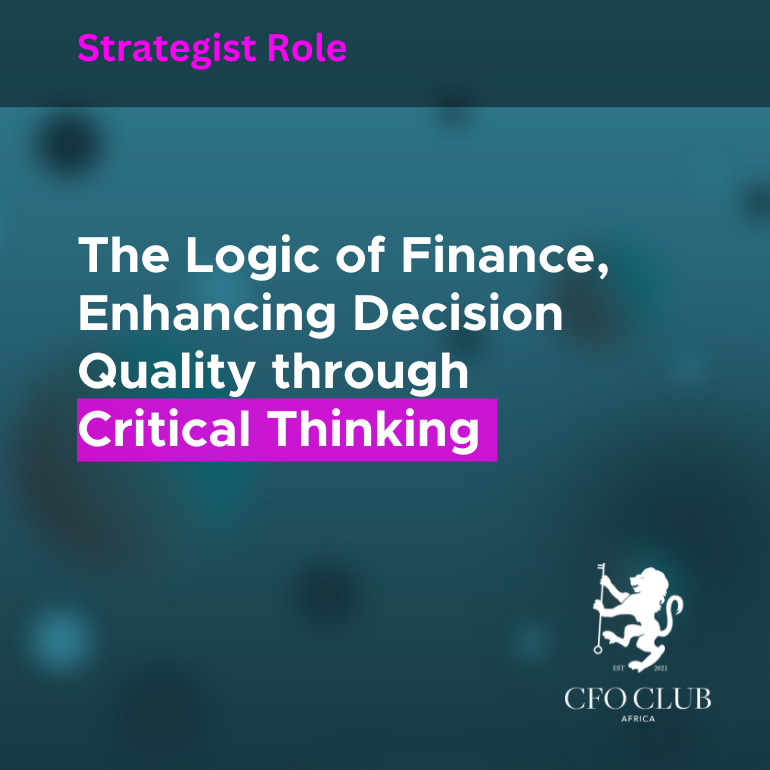The Logic of Finance, Enhancing Decision Quality through Critical Thinking
In corporate finance, CFOs are often required to make decisions that impact their organizations. The quality of these decisions largely depends on one key skill: the ability to think critically. Critical thinking in finance isn’t just about crunching numbers—it’s about using a clear, logical approach to solve problems and make better decisions. In this article, we’ll discuss how CFOs can improve their critical thinking skills to make more informed decisions, with practical examples you can apply in your daily work.
Understand the Problem Before Jumping to Solutions
The first step in critical thinking is to fully understand the problem before trying to fix it. Often, CFOs are under pressure to make quick decisions, which can lead to poor results if the problem isn’t fully understood.
Example: Imagine your company’s profit margins are shrinking. Instead of immediately cutting costs, which might seem like the obvious solution, take the time to analyze why this is happening. Is it because production costs are rising, sales are dropping, or maybe the supply chain is inefficient? By understanding the real cause, you can create a plan that solves the problem, not just the symptoms.
Practical Tip: Before making any major decision, ask yourself, “Do I really understand the problem? What information do I need to make a smart decision?” Make sure your team provides complete reports that cover all aspects of the issue, not just the most obvious ones.
Challenge Assumptions and Biases
Every financial decision is influenced by assumptions and biases, even if we don’t always notice them. Critical thinking involves recognizing and questioning these assumptions to make sure they don’t lead you astray.
Example: Suppose your company is considering merging with a smaller firm. You might assume that the merger will automatically increase your market share. But a critical thinker would question this assumption by considering potential risks, such as whether the two companies’ cultures will clash or if there will be integration issues that could harm the business.
Practical Tip: Regularly check the assumptions behind your decisions. For each major decision, list the key assumptions and ask, “What if this assumption is wrong? What proof do we have to support it?” This can help you avoid costly mistakes and ensure a more solid decision-making process.
Use a Structured Decision-Making Process
To improve the quality of your decisions, it’s helpful to use a structured process that guides you through each step. One such process is the OODA Loop (Observe, Orient, Decide, Act), which is used in both military and business settings.
Example: Let’s say you need to decide whether to invest in a new technology platform. By using the OODA Loop:
- Observe: Gather data about the platform’s features, costs, and benefits.
- Orient: Think about how this technology fits with your company’s goals and current systems.
- Decide: Weigh the pros and cons and make your decision based on the evidence.
- Act: Implement your decision and monitor its impact, being ready to make changes if needed.
Practical Tip: Include the OODA Loop or a similar decision-making process in your regular financial planning meetings. This will help you and your team stay focused and ensure that decisions are made logically and based on facts, not just gut feelings.
Bring in Different Perspectives
Getting different viewpoints is important for critical thinking because it helps you see the full picture and avoid “groupthink.” Encouraging input from different parts of the company can lead to better, more innovative decisions.
Example: If you’re considering a major investment, like opening a new production facility, don’t just rely on financial data. Get input from operations, marketing, and HR to understand the broader implications, such as potential production challenges or the availability of talent in the new area.
Practical Tip: Create a culture of collaboration by holding cross-functional meetings for big financial decisions. Encourage open discussions where team members feel comfortable challenging ideas and offering different viewpoints. This will lead to more informed and balanced decisions.
Keep Learning and Adapting
The business world is always changing, so your approach to decision-making should evolve too. Continuous learning is a key part of critical thinking, allowing you to adjust your strategies based on new information and changing circumstances.
Example: During the COVID-19 pandemic, many CFOs had to quickly adapt to remote work and changing customer behaviors. Those who critically assessed the situation, learned from new trends, and adjusted their strategies were better able to navigate the crisis.
Practical Tip: Make continuous learning a priority for yourself and your team. Stay up to date on industry trends, attend relevant seminars, and encourage your team to do the same. Regularly review past decisions to understand what worked, what didn’t, and why. This will help you make better decisions in the future.
Conclusion
Critical thinking is a must-have skill for CFOs who want to excel in today’s complex financial landscape. By taking the time to fully understand problems, questioning assumptions, using structured decision-making processes, bringing in different perspectives, and committing to continuous learning, you can improve the quality of your decisions and drive better results for your company. As you go about your daily tasks, remember that the best financial decisions are those made with a clear, logical, and critical mindset. Implement these strategies, and you’ll be well-equipped to handle whatever challenges and opportunities come your way.

